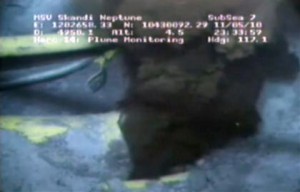Faulty "Fail-Safe" Responsible for Continuing Gushing in Gulf Oil Leak

A defective critical fail-safe is now being pointed to as one of the major reasons the Gulf Oil Leak gushing from the underground well has not been stopped. The Washington Post has more details of these shortcomings:
The blowout preventer was supposed to be the last line of defense against the type of spill spreading across the Gulf of Mexico. [Rep. Bart] Stupak said that the device’s manufacturer, Cameron, told committee staffers that the leak in the hydraulic system, which was supposed to provide emergency power to the rams that should have severed the drill pipe and closed the well, probably predated the accident because other parts were intact.
Stupak said the problem suggested inadequate maintenance by BP and Transocean. He also said that the shear ram, the strongest of the shutoff devices on the blowout preventer, was not strong enough to cut through joints that connected the 90-foot sections of drill pipe and covered 10 percent of the pipe’s length.
Although the oil itself is just now reaching the shores of Louisiana, Mississippi, and Alabama, real effects are being felt by the local tourism industry here in the Tampa Bay Area. Prospective guests have called to cancel reservations, citing the BP Oil Leak as the main reason, even though the oil remains hundreds of miles away from our shores. Local fishermen are concerned that once the oil reaches the Gulf’s Loop Current, their fishing grounds will be quickly affected by the adverse effects of the oil on the fish.
This crisis could have been prevented. In the past several years, we have allowed oil companies to reap great profits with the expectation they were putting in significant resources to not only research and development, but also safeguards to ensure the safety of the ecosystem surrounding their drilling sites.
Government regulations are slow to materialize in instances such as this, but the Civil Justice System has a proven track record of achieving real change for consumers. Here at Perenich The Law Firm, we are proud to be associated with the men and women who take large corporations to task for their negligence of public safety. An upcoming mini-series appearing on this blog will highlight the changes in automobile safety that were the result of Civil Litigation, not government regulation.
We can only hope that great minds can find a way to limit the damages of the oil that has already been gushed into the Gulf of Mexico, and our thoughts are with those who have already been directly affected.


